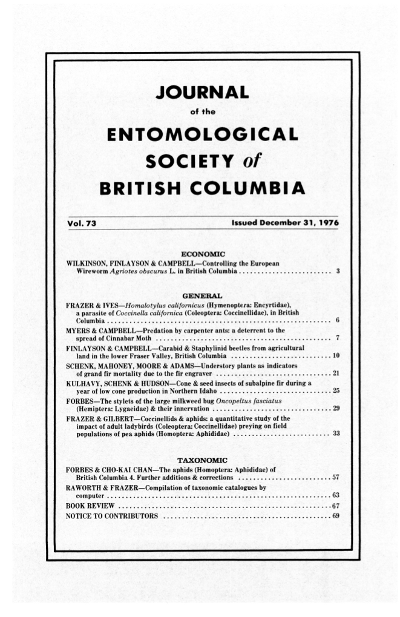Understory plants as indicators of grand fir mortality due to the fir engraver
Keywords:
grand fir, fir engraver, <i>Scolytus ventralis</i>Abstract
Mortality of grand fir trees, caused by the fir engraver, <i>Scolytus ventralis</i>, was monitored during 3 years on ten 0.1-acre (0.04 ha) circular plots in each of nine stands in northern Idaho. Understory vegetation was sampled on each plot on the basis of circular subplots of 0.03 acre (0.012 ha). Analyses showed four species to be strongly correlated with high and two with low tree mortality. The interaction between these groups of plant species provided a variable that increased as the proportion of high- to low-hazard plants increased. Various linear and nonlinear expressions were tested between the two plant groups and their interaction regressed against killed trees per acre. The plant group interaction term accounted for the most variation (r2=0.914) and produced the lowest standard error of the estimate (1.55). The equation for this variable took the form Y = 2.291 + 0.111ex. where X=plant group interaction. This equation provides an indication of the susceptibility of grand fir stands to mortality caused by the fir engraver.References
Ashraf, M. and A.A. Berryman. 1970. Biology of Sulphuretylenchus elongatus (Nematoda: Sphaerulariidae), and its effect on its host, Scolytus ventralis (Coleoptera: Scolytidae). Can. Entomol. 102:197-213.
Berryman, A.A. 1969. Response of Abies grandis to attack by Scolytus ventralis (Coleoptera: Scolytidae). Can. Entomol. 101:1033-1041.
Berryman, A.A. 1973. Population dynamics of the fir engraver, Scolytus ventralis (Coleoptera: Scolytidae), 1. Analysis of population behaviour and survival from 1964 to 1971. Can. Entomol. 105:1465-1488.
Berryman, A.A. and M. Ashraf. 1970. Effects of Abies grandis resin on the attack behaviour and brood survival of Scolytus ventralis (Coleoptera: Scolytidae). Can. Entomo. 102:1229-1236.
Daubenmire, R. and J.B. Daubenmire. 1968. Forest vegetation of eastern Washington and northern Idaho. Wash. State Univ., Agr. Exp. Sta. Tech. Bull. 60. 104 pp.
Fowells, H.A. (ed.). 1965. Silvics of forest trees of the United States. U. S. Dept. Agr., Agr. Handbk. 271. 762 pp.
Hitchcock, C.L. and A. Cronquist. 1973. Flora of the Pacific Northwest. U. of Wash. Press. 730 pp.
Keen, F.P. 1952. Insect enemies of western forests. U.S. Dept. Agr., Misc. Publ. 273. 280 pp.
Massey. C.L. 1966. The influence of nematode parasites and associates on bark beetles in the United States, Bull. Entomol. Soc. Amer. 12:384-386.
Partridge, A.D. and D.L. Miller. 1972. Bark beetles and root rots related in Idaho conifers. Plant Disease Reptr. 56:498-500.
Stevens, R.E. 1971. Fir engraver. U. S. Dept. Agr., Forest Service, Forest Pest Leafl. 13. 7 pp.
Struble. G.R. 1957. The fir engraver, a serious enemy of western true firs. U.S. Dept. Agr., Prod. Res. Rept. 11. 18 pp.
Wilson. A.K. 1962. Timber resources of Idaho. U.S. Dept. Agr., Forest Service, Intermt. Forest and Range Exp. Sta., Forest Survey Release 3. 42 pp.
Downloads
Published
Issue
Section
License
Authors who publish with the Journal of the Entomological Society of British Columbia agree to the following terms:
-Authors retain copyright and grant the journal right of first publication with the work simultaneously licensed under a Creative Commons Attribution License that allows others to share the work with an acknowledgement of the work's authorship and initial publication in this journal.
-Authors are able to enter into separate, additional contractual arrangements for the non-exclusive distribution of the journal's published version of the work (e.g., post it to an institutional repository or publish it in a book), with an acknowledgement of its initial publication in this journal.
-Authors are permitted and encouraged to post their work online (e.g., in institutional repositories or on their website) prior to and during the submission process, as it can lead to productive exchanges, as well as earlier and greater citation of published work (See The Effect of Open Access).


